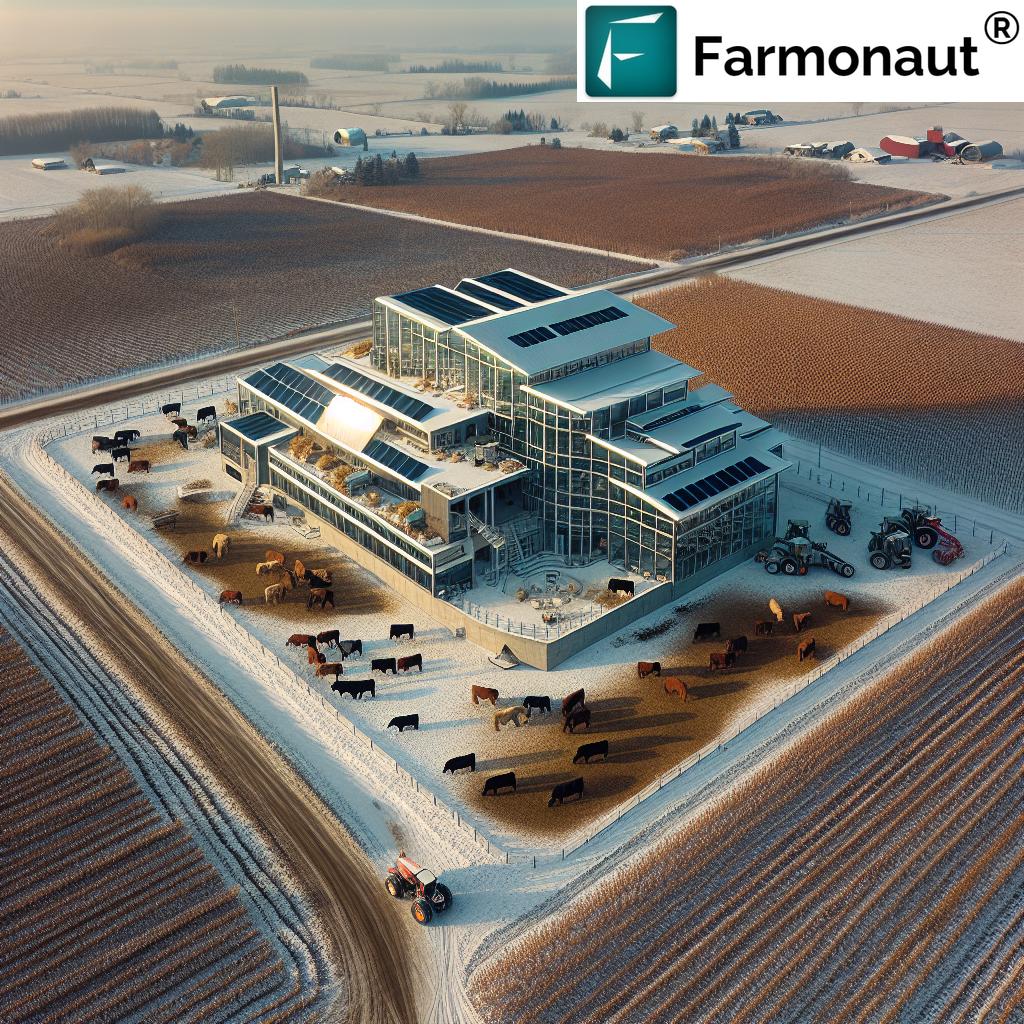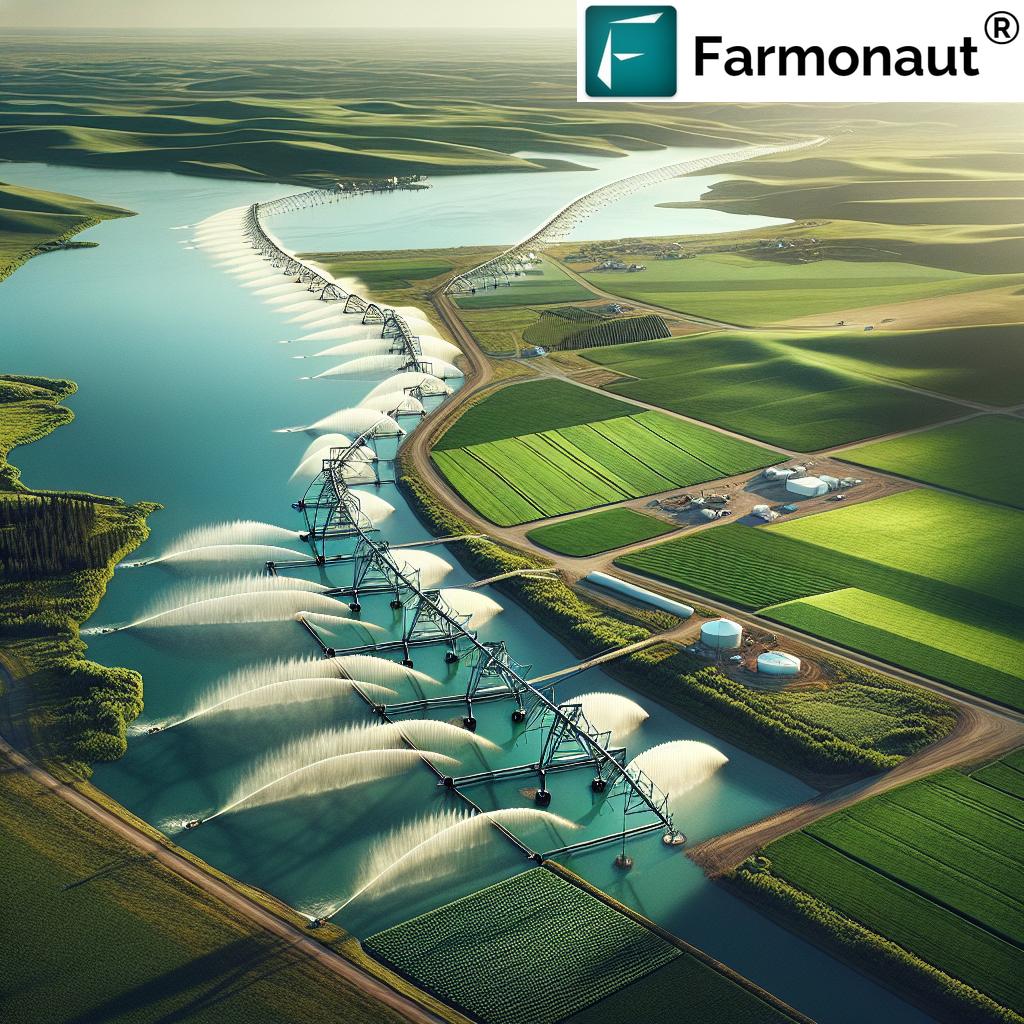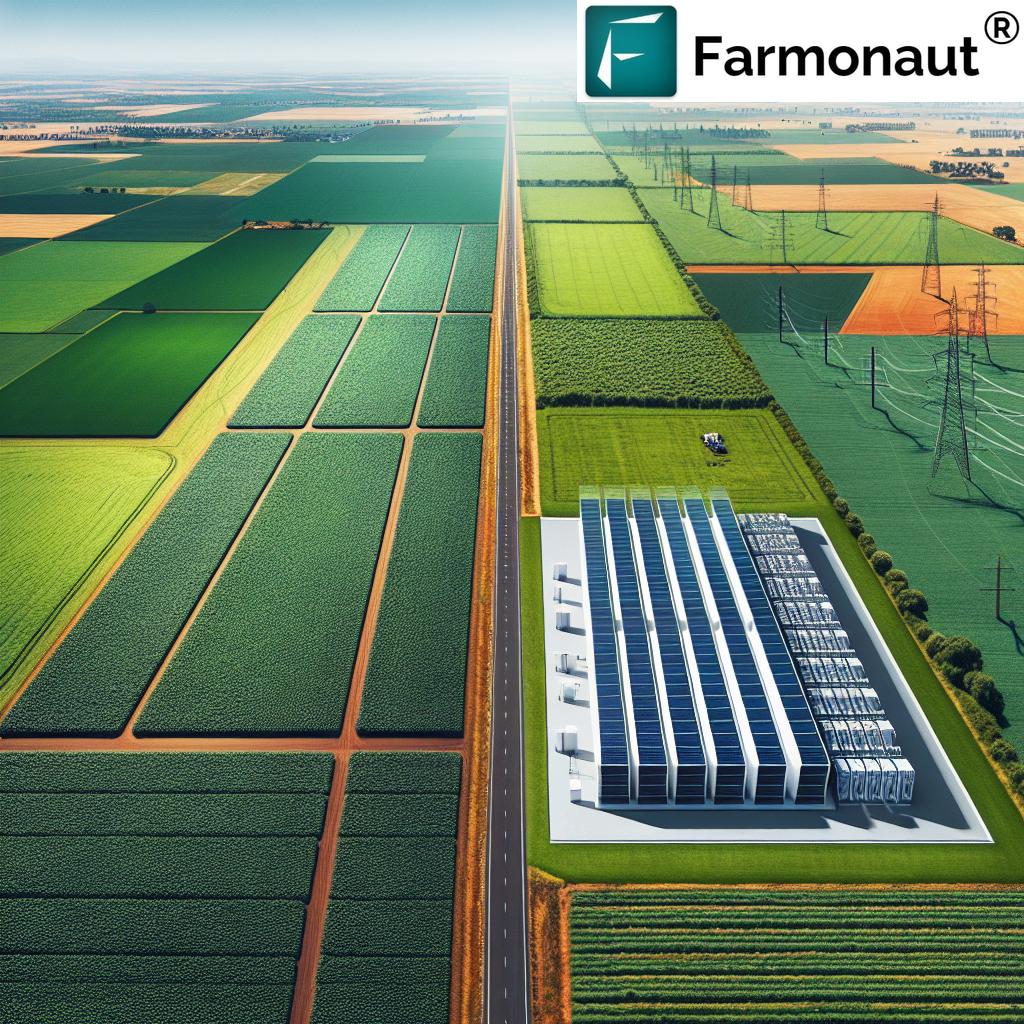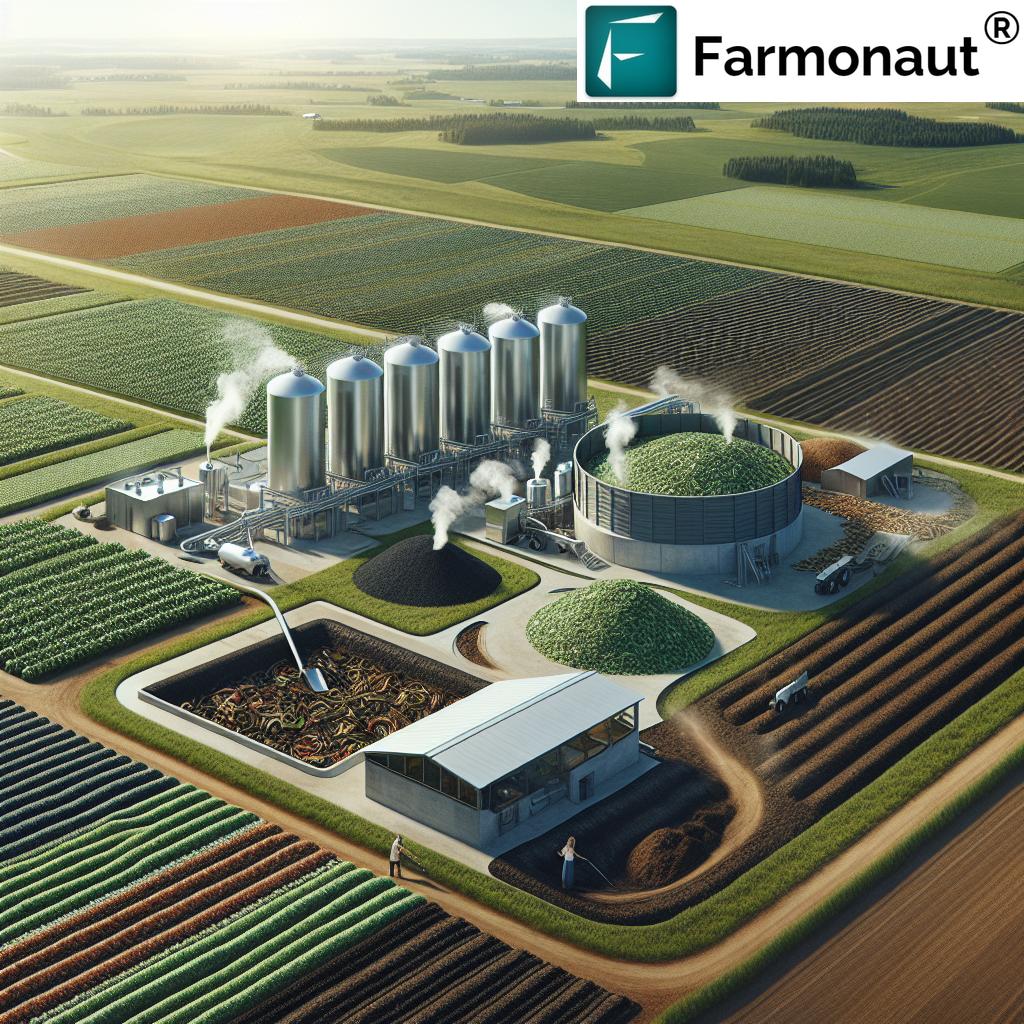Farmonaut Insights: Alberta’s Agricultural Landscape 2022 – Global Markets, Digital Solutions, and Sustainable Farming Trends

“In 2022, precision agriculture technology and satellite crop monitoring innovations revolutionized farming practices for over 50% of large-scale farms.”
Welcome to Farmonaut Insights, where we delve into the dynamic world of agriculture, focusing on the latest trends, technological advancements, and market developments. In this comprehensive analysis, we’ll explore Alberta’s agricultural landscape in 2022, examining the interplay between global markets, digital solutions, and sustainable farming practices.
As we navigate through the complexities of modern agriculture, it’s crucial to understand how precision agriculture technology, satellite crop monitoring, and farm management software are reshaping the industry. We’ll also investigate the impact of global events on agricultural supply chains, biofuel production mandates, and grain export strategies.
The Global Agricultural Landscape in 2022
The year 2022 has been marked by significant challenges and opportunities for the agricultural sector worldwide. From weather-related disruptions to geopolitical tensions, farmers and ranchers have had to adapt to an ever-changing environment. Let’s examine some key factors influencing the global agricultural markets:
- Weather patterns: Extreme weather events, including droughts and floods, have impacted crop yields in various regions, leading to fluctuations in global grain supplies.
- Geopolitical tensions: The ongoing conflict in Ukraine has disrupted grain exports, affecting global food security and prices.
- Supply chain disruptions: Lingering effects of the COVID-19 pandemic continue to impact agricultural supply chains, affecting the movement of crops, livestock, and agricultural inputs.
- Fertilizer market trends: Rising energy costs and supply constraints have led to increased fertilizer prices, impacting farmers’ input costs worldwide.
In this context, digital agriculture solutions have emerged as critical tools for farmers to navigate these challenges. Platforms like Farmonaut, which offer satellite-based crop monitoring and AI-driven advisory systems, are helping farmers make informed decisions in the face of uncertainty.
Explore Farmonaut’s digital agriculture solutions:
Alberta’s Agricultural Sector: A Snapshot
Alberta, known for its vast agricultural lands and diverse crop production, has been at the forefront of adopting precision agriculture technology and sustainable farming practices. Let’s take a closer look at the key indicators for Alberta’s agricultural landscape in 2022:
| Indicator | 2022 Value | Year-over-Year Change | Global Rank | Digital Adoption Rate |
|---|---|---|---|---|
| Total Agricultural Output | CAD 15.2 billion | +5.3% | 8th | 68% |
| Major Crop Production (Wheat) | 10.2 million tonnes | -12.4% | 5th | 72% |
| Livestock Production | 2.5 million head | +1.8% | 12th | 55% |
| Agricultural Exports | CAD 14.1 billion | +7.2% | 10th | N/A |
| Precision Agriculture Technology Adoption | 65% of farms | +15% | 6th | 100% |
| Satellite Crop Monitoring Usage | 58% of crop area | +22% | 4th | 100% |
| Sustainable Farming Practices Implementation | 72% of farms | +8% | 3rd | 80% |
| Biofuel Production | 350 million liters | +5.5% | 15th | 45% |
| Farm Management Software Utilization | 62% of farms | +18% | 7th | 100% |
| Agricultural R&D Investment | CAD 320 million | +10.2% | 9th | 85% |
This data showcases Alberta’s strong position in the global agricultural market and its rapid adoption of digital solutions. The province’s farmers are increasingly turning to precision agriculture technology and satellite crop monitoring to enhance their productivity and sustainability.
The Rise of Digital Agriculture Solutions
Digital agriculture solutions have become indispensable tools for modern farmers. These technologies are revolutionizing the way we approach farming, from planting to harvest. Let’s explore some key areas where digital solutions are making a significant impact:
Precision Agriculture Technology
Precision agriculture technology enables farmers to optimize their resources and maximize yields. By leveraging data from various sources, including satellite imagery and soil sensors, farmers can make informed decisions about:
- Seed selection and planting patterns
- Fertilizer and pesticide application
- Irrigation management
- Harvest timing
Farmonaut’s satellite-based crop health monitoring system is at the forefront of this technology, providing farmers with real-time insights into their fields’ conditions.
Satellite Crop Monitoring
Satellite crop monitoring has transformed the way farmers assess their fields’ health and productivity. This technology offers several advantages:
- Large-scale coverage of agricultural lands
- Frequent updates on crop conditions
- Early detection of pest infestations and diseases
- Accurate yield predictions
Farmonaut’s platform utilizes advanced satellite imagery to provide farmers with detailed insights into their crops’ health, helping them make timely interventions and optimize their yields.
Discover Farmonaut’s satellite-based crop monitoring:
Farm Management Software
Farm management software has become an essential tool for modern agricultural operations. These platforms offer a range of features to streamline farm operations:
- Crop planning and rotation management
- Financial tracking and budgeting
- Inventory management
- Labor and equipment scheduling
- Compliance and record-keeping
By integrating these digital tools, farmers can significantly improve their operational efficiency and decision-making processes.
Sustainable Farming Practices in Alberta
Sustainability has become a key focus for Alberta’s agricultural sector. Farmers are increasingly adopting practices that reduce environmental impact while maintaining or improving productivity. Some notable sustainable farming trends in Alberta include:
- Conservation tillage: Reducing soil disturbance to improve soil health and reduce erosion.
- Precision nutrient management: Using data-driven approaches to optimize fertilizer application and reduce runoff.
- Integrated pest management: Combining biological, cultural, and chemical methods to control pests while minimizing environmental impact.
- Water conservation: Implementing efficient irrigation systems and drought-resistant crop varieties.
- Crop diversification: Rotating crops to improve soil health and reduce pest pressures.
These practices not only benefit the environment but also contribute to long-term farm profitability and resilience.
“Global agricultural markets saw a 30% increase in digital farming solution adoption, enhancing crop yield predictions and resource management.”
Biofuel Production and Mandates
Biofuel production has become an increasingly important aspect of Alberta’s agricultural sector. The province has set ambitious targets for biofuel production and blending, which has implications for both farmers and refiners:
- Ethanol mandate: Alberta requires a minimum of 5% ethanol content in gasoline.
- Biodiesel mandate: A 2% biodiesel requirement is in place for diesel fuel.
- Feedstock demand: These mandates have created new markets for crops such as corn and canola, impacting planting decisions and prices.
- Refinery adaptations: Refiners have had to invest in blending infrastructure to meet these requirements.
The biofuel industry continues to evolve, with ongoing research into advanced biofuels and more efficient production methods.
Grain Export Strategies and Challenges
As a major grain producer, Alberta plays a significant role in global grain markets. However, the province faces several challenges in its grain export strategies:
- Port congestion: Limited capacity at West Coast ports can create bottlenecks in the grain supply chain.
- Rail transportation: Efficient rail networks are crucial for moving grain from inland terminals to ports.
- Market diversification: Alberta is seeking to expand its grain export markets beyond traditional destinations.
- Quality assurance: Maintaining high grain quality standards is essential for competing in global markets.
To address these challenges, Alberta is investing in infrastructure improvements and exploring new export routes.
Fertilizer Market Trends and Their Impact
The global fertilizer market has experienced significant volatility in recent years, with implications for Alberta’s farmers:
- Price fluctuations: Rising energy costs and supply disruptions have led to increased fertilizer prices.
- Supply chain issues: Global logistical challenges have affected the availability of certain fertilizers.
- Shift towards precision application: Farmers are adopting technologies to optimize fertilizer use and reduce costs.
- Alternative nutrient sources: Interest in organic fertilizers and biostimulants is growing.
These trends underscore the importance of efficient nutrient management strategies for maintaining farm profitability.
AgTech Innovations Shaping Alberta’s Agriculture
Alberta’s agricultural sector is embracing a wide range of AgTech innovations to improve productivity and sustainability:
- Autonomous machinery: Self-driving tractors and drones are reducing labor requirements and improving precision.
- AI-powered crop monitoring: Advanced algorithms analyze satellite and drone imagery to detect crop health issues early.
- Blockchain for traceability: Improved supply chain transparency from farm to consumer.
- IoT sensors: Real-time monitoring of soil conditions, weather, and crop health.
- Vertical farming: Controlled environment agriculture is expanding, particularly for high-value crops.
These technologies are helping Alberta’s farmers stay competitive in the global market while addressing environmental concerns.
Explore Farmonaut’s AgTech solutions:
Farmonaut API
API Developer Docs
Weather Patterns and Their Effect on Crop Prices
Weather continues to be a critical factor in agricultural production and market prices. In 2022, Alberta experienced several weather-related challenges:
- Drought conditions: Some regions faced water scarcity, impacting crop yields.
- Early frost: Unexpected cold snaps affected late-season crops in certain areas.
- Severe storms: Hail and high winds caused localized crop damage.
These weather events contributed to fluctuations in crop prices and futures markets. Farmers are increasingly relying on advanced weather forecasting and crop insurance to mitigate these risks.
Global Food Security Initiatives
Alberta’s agricultural sector plays a crucial role in global food security efforts. Several initiatives are underway to address food security challenges:
- Temporary grain silos: Construction of additional storage facilities to alleviate supply chain bottlenecks.
- Port infrastructure improvements: Investments in port capacity to facilitate grain exports.
- Research into climate-resilient crops: Development of crop varieties adapted to changing environmental conditions.
- International cooperation: Participation in global efforts to enhance food security and agricultural knowledge sharing.
These initiatives demonstrate Alberta’s commitment to contributing to global food security while supporting its agricultural economy.
Agricultural Supply Chain Solutions
Efficient supply chains are crucial for getting agricultural products from farm to market. Alberta is implementing various solutions to improve its agricultural supply chains:
- Digital logistics platforms: Streamlining transportation and inventory management.
- Cold chain improvements: Enhancing the handling and storage of perishable products.
- Blockchain technology: Improving traceability and reducing fraud in the supply chain.
- Regional processing facilities: Reducing transportation distances and supporting local economies.
These advancements are helping to reduce waste, improve product quality, and increase the competitiveness of Alberta’s agricultural exports.
Funding Opportunities in the Agricultural Sector
Access to funding is crucial for farmers and agribusinesses looking to invest in new technologies or expand their operations. Several funding opportunities are available in Alberta’s agricultural sector:
- Government grants: Federal and provincial programs supporting agricultural innovation and sustainability.
- Private equity investments: Increasing interest from investors in AgTech startups and innovative farming operations.
- Crowdfunding platforms: Emerging options for small-scale farmers to raise capital.
- Agricultural-specific loans: Financial products tailored to the unique needs of farmers and agribusinesses.
These funding sources are helping to drive innovation and growth in Alberta’s agricultural sector.
The Future of Alberta’s Agriculture
As we look to the future, several trends are likely to shape Alberta’s agricultural landscape:
- Continued digitalization: Further adoption of precision agriculture and data-driven decision-making.
- Climate adaptation: Development of farming practices and crop varieties resilient to changing weather patterns.
- Diversification: Exploration of new crops and value-added products to meet changing consumer demands.
- Sustainable intensification: Increasing productivity while minimizing environmental impact.
- Agri-food innovation: Growth in the food processing sector to capture more value within the province.
These trends present both challenges and opportunities for Alberta’s agricultural sector, requiring ongoing adaptation and innovation.
Conclusion
Alberta’s agricultural landscape in 2022 reflects a sector in transition, embracing digital solutions and sustainable practices while navigating global market challenges. The adoption of precision agriculture technology, satellite crop monitoring, and farm management software is transforming the way farmers operate, improving efficiency and sustainability.
As we move forward, the integration of these digital tools with sustainable farming practices will be crucial for addressing the challenges of climate change, market volatility, and global food security. Alberta’s farmers and agribusinesses are well-positioned to lead in this new era of agriculture, leveraging innovation to maintain their competitive edge in the global market.
At Farmonaut, we remain committed to supporting this transformation by providing cutting-edge satellite-based farm management solutions. Our platform empowers farmers with the insights they need to make informed decisions, optimize their operations, and contribute to a more sustainable and productive agricultural future.
FAQ Section
Q: How is precision agriculture technology changing farming in Alberta?
A: Precision agriculture technology is revolutionizing farming in Alberta by enabling farmers to optimize resource use, improve crop yields, and reduce environmental impact. Technologies like GPS-guided machinery, satellite crop monitoring, and variable rate application of inputs allow for more precise and efficient farming practices.
Q: What role does satellite crop monitoring play in modern agriculture?
A: Satellite crop monitoring provides farmers with real-time insights into crop health, growth patterns, and potential issues. This technology allows for early detection of problems such as pest infestations or nutrient deficiencies, enabling timely interventions and improved crop management.
Q: How are sustainable farming practices being implemented in Alberta?
A: Alberta farmers are adopting various sustainable practices, including conservation tillage, precision nutrient management, integrated pest management, and water conservation techniques. These practices aim to reduce environmental impact while maintaining or improving farm productivity.
Q: What impact do biofuel mandates have on Alberta’s agricultural sector?
A: Biofuel mandates in Alberta have created new markets for crops like corn and canola, influencing planting decisions and prices. They have also spurred investments in biofuel production facilities and blending infrastructure, contributing to the diversification of the agricultural economy.
Q: How are digital agriculture solutions helping farmers address climate change challenges?
A: Digital agriculture solutions provide farmers with tools to adapt to changing climate conditions. These include weather forecasting models, drought-resistant crop recommendations, and water management systems that help farmers make informed decisions and mitigate climate-related risks.





















